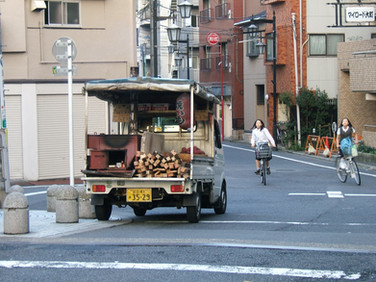Inspiration Part I: The Setting
- C E Huntingdon

- Mar 27, 2021
- 4 min read
Updated: Apr 2, 2021
Twelve years ago we had the opportunity to spend four years in Tokyo, and what an amazing four years it was. What started out as an opportunity to learn and study, grew into a massive adventure that seemed to last several lifetimes. It was this adventure that thankfully sparked our inspiration for A Simple Thought of Sanity. Something we'd like to explore, and hopefully, you will too, is looking back at the inspiration for our book. Over the coming weeks, we'll be off-and-on writing about the different aspects that we learned and drew from.
Tokyo

From the perspective of a foreigner, Tokyo is an endless cityscape. When looking from the top of the tallest tower in Japan, all you can see is city, up to the edge of the horizon. These endless streets that we wound our way through each day would eventually become the landscape for Brutus' metropolis. In reality, though, they are far from the alabaster monuments and the mundane concrete of the "City" we describe in our book.

Tokyo is both old and new. As the streets twist and wind together, so does the past and present of this amazing city. It is impossible to go for a walk anywhere in Japan and not stumble upon something interesting. We always wondered if our awe of the city we lived in came from our foreign perspective, and if those who had lived their whole lives there felt in any way the same. Though, coming from a small town with a population of 9,000, we might have just been easily impressed.
By now, if you've read the book, you might be wondering, how do alabaster concrete slabs of perfection in any way compare to this jumble of aesthetic styles that we've presented? It all has to do with trash, or the lack thereof. While a total lack of trash might be going a bit far, it's safe to say your hope of finding a receptacle in which to deposit that pesky wrapper in your pocket is a bit of a fool's errand. Perhaps in any other place, a lack of trash cans would obviously equate to an abundance of nasty things strewn about. In Japan, it meant a spotless city.
That didn't mean of course that every person in Japan was neat and tidy and never dropped the odd bit of lint here and there. But for all those stray and errant things, someone was always there to pick them up. The city government employed many a fine person, usually clothed in some solid color of jumpsuit, to make sure each part of the city was spotless and well maintained. Of course, the old peaks out from the new, and while you'll see a rusted gutter here and a crumbling stone wall there, a sort of reverence and respect for even the most rustic of facilities is maintained.
For us, the City we created is a Tokyo stripped of all its wonder and personality. It's the idea of a grand metropolis in which one doesn't take the time to stop and simply look.

One day in our art history class, our professor wove a fine tale about the beautiful piece of art she was presenting to us. It was a boldly colored Edo-era piece, with a beautiful river snaking its way across a gorgeous landscape. She then told us that we passed over a part of that river twice daily on our way to school when we tromped across the brown, dirty, and on most days very smelly canal. We found ourselves extremely skeptical that the deep blue river and that muddy canal were one and the same. So, our professor continued.
Apparently, a concrete company had an in with the government and at some point in recent history, had "convinced" Tokyo that what the rivers really needed was wall-to-wall paving. True or not, it makes a great background for a dystopian world where nature is second to concrete.

Being in a foreign country, unable to speak the language (or at least, unable to say much more than, 'yes,' 'no,' 'I don't understand,' and 'one bowl of ramen, please') and surrounded by so many people, we often found ourselves surprised at how easy it was to feel alone.
With all these places and the vastness between points, at times we felt a bit world-weary. Every day felt like a week, and every week a month. The sheer amount of effort to simply get to your first train in the morning could feel overwhelming.
This feeling of isolation, even when shoulder to shoulder, is something we tried to draw heavily from for our work.
And I'm sure you're also thinking, well, you were there for four years, you should have learned the language, that would have helped. And that's true, but unfortunately, we found the traditional style of learning Japanese to be more than a little intensive and we thought to ourselves, 'We have time to either learn the language or to explore the country and meet its people.' We chose the latter.
And how glad we are that we did, because as much as we've painted Tokyo as a dreary and sad place, it's filled with some wonderful things, and even more wonderful people.
We are strange folk by nature and often excel at being contrary. So it's easy for us to find all that's bad and strange in any given situation. But really, Tokyo is a place filled with life and joy. And we whole-heartily recommend, if you ever have the chance to visit, that you do.
Even though we now live on the Oregon Coast, our hearts will always be lost in those winding streets of Tokyo.




















Comments